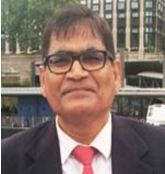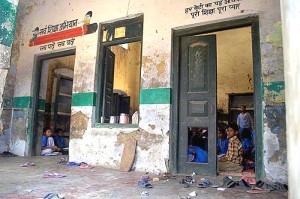
 Prof Satya Narayan Misra and Ms Abhipsa Ray* in Bhubaneswar, January 2, 2024: The World Health Organisation (WHO) notes that children and adolescents with disability have higher odds than their counterparts without disability of dropping out of upper secondary education (27%), experiencing discrimination (41%), and feeling unhappy (51%). Article 24, 2(a) of the UN Convention on Rights of Children with Disability (UNCRPD) 2008 states that people with disabilities should not be excluded from the mainstream because of their impairment.
Prof Satya Narayan Misra and Ms Abhipsa Ray* in Bhubaneswar, January 2, 2024: The World Health Organisation (WHO) notes that children and adolescents with disability have higher odds than their counterparts without disability of dropping out of upper secondary education (27%), experiencing discrimination (41%), and feeling unhappy (51%). Article 24, 2(a) of the UN Convention on Rights of Children with Disability (UNCRPD) 2008 states that people with disabilities should not be excluded from the mainstream because of their impairment.
Drawing upon such mandates, The RPWD Act of 2016 provides a legal framework for guaranteed education to disabled children without discrimination. It directed the schools to make the school environment (including all physical facilities) barrier-free and accessible, admit students without discrimination, and upskill the regular classroom teacher and special teacher to cater special education needs of students with a broad spectrum of disability.
NEP 2020 has actively stated about making education inclusive and calls upon the states to hire special educators and render assistive equipment and necessary technology-based tools. According to a study by UNESCO (2019), 75 percent of the total of 78.64 lakh disabled children in India, under the age of five, is not enrolled in any kind of school setting. The survey also notes that 27% of disabled children have never had the opportunity to enrol in any type of educational institution, while 12% have dropped out of school. Accessibility, availability, affordability, and acceptability remain major challenges in the Indian context.
Our study aims to study the perception and experience of inclusive education through the lens of disabled students in the district of Khurda in Odisha through a mixed method research, by analysing data both quantitatively and qualitatively.
The purpose of this study is to bridge this gap by examining the unique experiences of each student in the classroom, examining the subtleties of the teaching-learning process, instances of discrimination in educational settings, and identifying the specific causes of rising dropout rates among children with disabilities in primary, secondary and higher secondary schools. By conducting this research, it seeks to provide crucial perspectives that transcend the limitations of the current policy structure, promoting a more comprehensive and inclusive strategy for inclusive equality education.
 While 92% of students do not have desks with adequate space, 76% of classrooms are not well equipped and 49% did not find classrooms to be accessible in wheelchairs. Counselors are not readily available (95%) and writers for students are conspicuous by their absence. Further nearly two-thirds of children reported that they do not get all books and materials on time from the school library.
While 92% of students do not have desks with adequate space, 76% of classrooms are not well equipped and 49% did not find classrooms to be accessible in wheelchairs. Counselors are not readily available (95%) and writers for students are conspicuous by their absence. Further nearly two-thirds of children reported that they do not get all books and materials on time from the school library.
The findings from the pilot survey also show that all schools have barrier-free entry and movement inside the campus. Though washrooms are easy to operate wheelchairs are not accessible. Classrooms are not fully equipped to cater varied needs of (Children with Special Needs) CWSN. The present curriculum appears to be a roadblock for CWSN in general classrooms. Though we have been successful in making the school campus barrier-free, there is a definite need to make the classrooms’ teaching and learning environment more accommodative and helpful in meeting the special needs of children.
A significant proportion of students (45%) reported being called by different names by teachers and friends based on their disability. Such name-calling was lower among girls. This repugnant practice can be minimized through sensitization programs.
The pilot study encountered that a major portion (86 percent) have only motor impairments, i.e. having a disability in the hand/legs, etc..They did not find much difficulty in studying. However, once a larger sample with different types of disability is studied, it will provide insight into the kind of difficulty they are encountering in terms of study, interaction with teachers, and support staff, and the extent to which they are getting quality education at par with normal children as envisaged in NEP 2020.
Accordingly, the inclusion of a substantial subset from special schools is essential for gaining insights into the unique challenges and successes in providing education to students with special disabilities. The experiences of teachers in special schools inform targeted strategies and support systems tailored to the specific needs of this particular student demographic. It highlights the importance of crafting interventions that recognize and address the distinctive aspects of teaching in dedicated settings for students with special needs. Teachers and administrators can learn from each other’s experiences, fostering a more cohesive and supportive educational environment for all students, regardless of their abilities.
The existing literature shows mixed results as to whether children with disability should be part of special schools or general schools. Our pilot study shows that 55% of teachers believe that they should be placed with other disabled children for better learning and less discrimination.
The NEP 2020 rightly recognizes that we have miles to go before the RPD Act 2016 finds fruition. It categorically recommends that Divyangs should have the same opportunity to obtain quality education as any other child (Para 6.2.5). It suggests “Separate strategy will be formulated for focused attention on reducing the gaps in school education.” Some of the suggestions include one-to-one teachers and instructors, open schooling, appropriate infrastructure, and suitable technical intervention. Our field study based on education in general schooling and special schooling for students with disability reveals that while we have gone a long way in improving infrastructure and open schooling, focused attention of teachers and suitable technological intervention are still not materialized substantively.
The study highlights four major challenges mainly: attitude, sensitization, appropriate skilling, and adequate budget allocation for disabled children.
The common refrain in all schools is the obnoxious practice of name-calling by both teachers and staff members. The government would need to mount suitable sensitization programs by conducting workshops, seminars etc. The training requirements of teachers and periodic upgradation with best global practices must be made a regular part of teachers’ training.
 It is also strongly recommended budgets for providing assistive technologies to children with disability should be substantially augmented, both by the state and central government. As the eminent biologist E.O. Wilson had observed: We have stumbled into the 21st century with Stone Age emotion, medieval institution, and God-like technology.” Children with special needs do not our need charity but equal human rights as normal children.
It is also strongly recommended budgets for providing assistive technologies to children with disability should be substantially augmented, both by the state and central government. As the eminent biologist E.O. Wilson had observed: We have stumbled into the 21st century with Stone Age emotion, medieval institution, and God-like technology.” Children with special needs do not our need charity but equal human rights as normal children.
Provision of assistive devices and technology to receive a quality education at par with normal children by providing an adequate budget, and training of teachers and support staff must receive the highest priority. This humungous problem cannot be left at the doors of the government but must receive the attention of an empathetic society that puts a premium on fostering an inclusive society. Stephen Hawkins, the celebrated cosmologist who suffered from motor neurone disease for more than 50 years wrote “ My advice to other disabled people would be to concentrate on things your disability does not prevent you from doing well. Do not be disabled in spirit as well physically”
*Prof Misra is actively engaged in disability issues.
Ms Abhipsa is doing Ph.D. under his supervision



Leave a Reply
1 Comment on "Inclusive Education for the Disabled: Preliminary Findings From Odisha"
Exploring the intricacies of inclusive education in the Indian context is not just essential but imperative. ‘Discovering Hennur’s Educational Landscape’ sheds light on the transformative power of inclusive practices, bridging gaps and fostering a more equitable learning environment for all. As we navigate through this insightful piece, it becomes evident that embracing diversity enriches the educational fabric of our society, paving the way for a brighter, more inclusive future. Kudos to the author for highlighting such a crucial aspect of education!